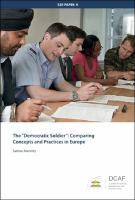The "Democratic Soldier"
Comparing Concepts and Practices in Europe
Abstract
Since the end of the Cold War almost all European countries have reformed their armed forces, focusing on downsizing, internationalization and professionalization. This paper examines how these changes in security sector governance have affected the normative model underlying the militaryâ s relationship to democracy, using the image of the â democratic soldierâ . Drawing on a comparative analysis of 12 post-socialist, traditional and consolidated democracies in Europe, the different dimensions of the national conception of soldiering are analysed based on the official norms that define a countryâ s military and the ways in which individual members of the armed forces see their role. Cases converge around the new idea of professional soldiering as a merging of civilian skills with military virtues in the context of the militaryâ s new post-Cold War missions. Yet despite this convergence, research also shows that specific aspects of national traditions and context continue to influence the actual practice of soldiering in each case. The contradictions that result between these old and new visions of the role of the military and the soldier illustrate the tensions that exist between political goals and defence reform dynamics.
Keywords
security sector reform; good governance; civil‐military relations; military reform; military power; armed forcesDOI
10.5334/bbtISBN
9781911529361OCN
1100489738Publisher
Ubiquity PressPublisher website
https://www.ubiquitypress.com/Publication date and place
London, 2013Series
SSR Papers, 9Classification
Politics and government
Warfare and defence


 Download
Download